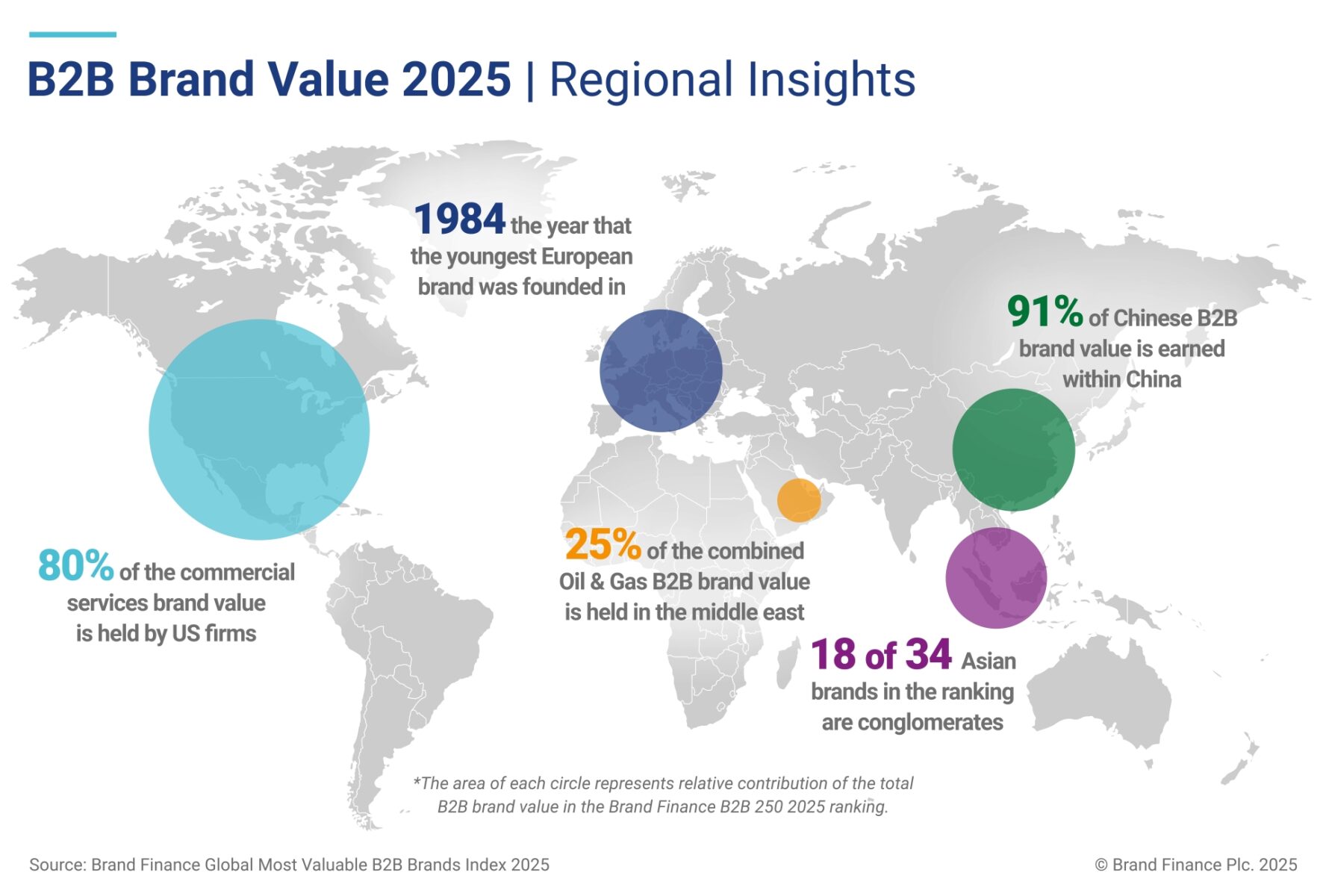Read the Brand Finance Global Most Valuable B2B Brands Index 2025 online now.
There was a fitting symmetry to launching the Brand Finance Global Most Valuable B2B Brands Index 2025 inside LinkedIn’s brand-new Experience Centre: a venue purpose-built to turn ideas into economic value, hosting the rankings that prove precisely how business-to-business brands do the same.
A higher-stakes league table
When Brand Finance chairman David Haigh first floated the idea of a dedicated B2B ranking, even he worried the exercise might be “too much effort”. Three years on, the Index has scaled from 100 to 250 brands worth USD3.3 trillion in aggregate, and Haigh used the launch to trail an ambitious leap to 500 brands in 2026.
The wider sample is more than a vanity metric:
- 36% of the value in Brand Finance’s Global 500 now comes from B2B business lines.
- Half the brands analysed serve both business and consumer segments, forcing marketers to master B2B-to-B2C, B2B-to-G and hybrid models.
- Brand strength still correlates with CFO-grade outcomes: stronger B2B brands borrow at up to 400 bps lower rates and their CEOs accept materially lower compensation - evidence, as Haigh quipped, that “brand makes you rich enough to pay your boss less.”
Brand to demand: six-pillar proof
Stein IAS’s newly refreshed identity made its public debut on the day, giving Global President Craig Duxbury the perfect prop to discuss the agency’s “Brand-to-Demand” framework. David Haigh endorsed the six-pillar model as “exactly what accountants need marketing to look like”: investment planning up-front, hard effectiveness measurement at the back, creativity and experience powering the middle.
Live data, real money
Valuation Director Hugo Hensley dived into the numbers behind the rankings:
- Microsoft retains the No. 1 slot, edging out Amazon, Google and Nvidia.
- Nvidia tops the fastest-growing list for the second year running, its brand value up 62% as it continues to pivot from consumer-facing GPUs to business-facing AI infrastructure.
- Europe adds the most newcomers. This is proof, Hensley argued, that the continent’s so-called “Mittelstand” is finally embracing brand as an export accelerator.
As an accountant-turned-storyteller, Hensley also revealed fresh work with System 1 linking emotional B2B advertising to swings in Brand Strength Scores: Adobe’s five-point brand-strength dip coincided with a 9% drop in value, only reversing when the firm switched back to high-emotion creative last year.
Panels that cut through the noise
HSBC CMO Nicole German, Wolters Kluwer VP Marcelo Amstalden Möller, TCS global marketer Vikrant Gaikwad, and Duxbury compared tactics for turning balance-sheet brand value into P&L growth. Three common threads emerged:
- Relentless simplification – “Do fewer things, execute completely, or don’t do them at all,” German urged.
- Consistency over novelty – Amstalden Möller is running Wolters Kluwer’s first-ever global brand campaign in its 190-year history, but only after three years of internal alignment and budget modelling.
- Group-based persuasion – Gaikwad’s marathon sponsorship programme reaches clients, prospects and 8,000 employees simultaneously, generating USD49 million for charity and priceless “memory equity” for TCS.
LinkedIn’s Mimi Turner and WARC Chief Content Officer David Tiltman unveiled research arguing that that 40% of enterprise deals stall because hidden buyers (procurement, finance, legal, and HR) cannot reach a consensus. The antidote: build buyability. This is collective confidence that a brand is the safest choice, achieved through broad-reaching brand campaigns that create trust signals long before an RFP is even issued.
Why it matters
The day’s most-quoted slide showed B2B brands trading at just 13% brand-to-enterprise-value ratios versus 18% in B2C. Closing that gap even halfway would create hundreds of billions of dollars in shareholder value. The Brand Finance Global Most Valuable B2B Brands Index is therefore more than a scoreboard; it is a roadmap to help boards that are still stuck in treating brand as a discretionary spend.
Looking ahead
By next May, Brand Finance intends to double the Index again, slice the results by sector, and, crucially, quantify buyability within the Brand Strength methodology. If 2025 proved anything, it is that the conversation has already moved from “does brand matter?” to “how fast can we turn brand into cash flow?”
For everyone at the LinkedIn Experience Centre on 14 May, that future felt considerably closer.

Read the Brand Finance Global Most Valuable B2B Brands Index 2025 online now.
